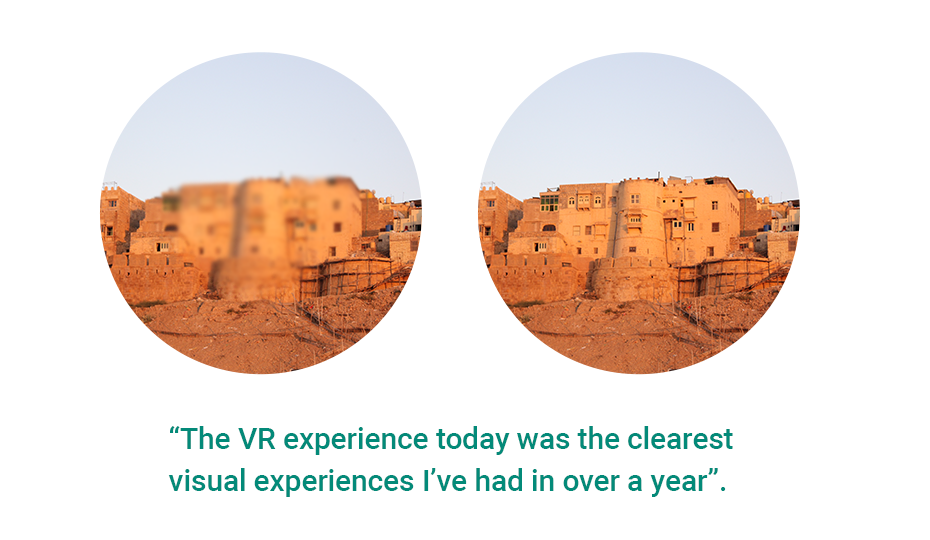How Virtual Reality Benefits Seniors
How Virtual Reality Benefits Seniors
Shattering assumptions to meet unique needs


You might not associate video games with the elderly population, but gaming is becoming increasingly popular with this growing demographic. There’s even a
But games can be serious business, too. Virtual reality (VR) games designed for rehabilitation can help improve abilities such as memory, cognition, attention, mental flexibility, and speed. These experiences can even combine cognitive improvement with physical exercise. Considering the growth of the elderly population and advancements in research, VR applications and games have the potential to be more than just entertainment targeted toward younger audiences.
Ties between physical and mental health during aging
As a UX design intern at Microsoft this past summer, I investigated VR opportunities for the elderly. As part of my research, elderly customers played an underwater VR game. One of the participants was overcome with emotion as she told us she had macular degeneration. The VR experience was the clearest she had seen in over a year.


The senior population often yearn for interaction and mental stimulation. They are eager to learn, explore and interact. While passive experiences provide emotional stimulation, they lack interaction.

This need for stimulation is likely a result of the physical and cognitive decline that comes with aging. As you age, your eyes receive only a third of the light younger eyes receive. Differentiating between colors becomes harder. Decline in hearing makes daily conversations difficult, causing a feeling of isolation. As these challenges intensify, they often bring depression, anxiety and a general decline in mental well-being.
Virtual reality, tangible benefits
VR offers a therapeutic solution to these challenges in elder healthcare. In many cases, it’s better than the real-world counterpart of the therapy. In fact, a study from the University of Maryland reported an 8.8% improvement in overall recall accuracy when using VR headsets to learn new information compared to traditional methods. Here are just a few examples of the potential of VR as a healthcare tool.
1. Early detection of cognitive impairment
Decline in memory and spatial reasoning are common challenges that come with aging and can often be early symptoms of Alzheimer’s or dementia. Doctors can detect these issues through VR navigation games where players must orient themselves in new environments. This type of test is difficult to execute in a traditional clinical setting.
Sea Hero Quest is one such game that gathers data to research dementia through VR gaming.
2. Physical and cognitive training
VR can help train motor and cognitive skills. Research shows the elderly can not only improve but build new motor and mental skills even at an advanced age. VR can improve balance, gait, and neural connections. In fact, study shows that playing a 3D video game designed to train multi-tasking abilities brings seniors’ performance to the level of a 20 year old after only one month of training. VR offers a therapeutic solution to these challenges in elder healthcare.
3. Reminiscence therapy
Reminiscence therapy is used as an intervention for patients with dementia. This therapy uses nostalgic feelings from photos or objects as a therapeutic tool. Nostalgia produces positive emotions, reduces stress, and can strengthen cognitive memory components.
This is where VR comes in: it helps make the experience real, facilitating the feeling of “being there.” It triggers therapeutic memories more effectively than an old photograph by providing highly immersive nostalgic experiences.
4. Distraction from pain
VR also helps in chronic pain management and distraction therapy — an escape into an immersive world to distract the brain from pain without medication. VR is used in critical surgeries, such as wound cleaning for burn patients. The patient transports to an immersive virtual world to distract from excessive pain.
Challenges and opportunities
VR brings its own challenges. Headsets are expensive and heavy, and older gamers often need assistance with them. However, we can overcome challenges using this technology in the right context. For example, we can design games or experiences players can access while sitting. And with more affordable VR headsets and software reducing barriers of entry, it’s now easier for people to create their own immersive experiences.
Traditional VR controllers are also not ideal for audiences with declining motor control. During my research, I tested the Xbox adaptive controller with elderly players. While the adaptive controller is currently not a fully compatible input for VR experiences for the elderly, it is definitely better received than any traditional controllers in the market. It has the potential to help make VR experiences more accessible and inclusive for the elderly.

What’s next?
By 2060, the elderly population will account for 23.5% of the U.S. population (source). This will more than double today’s elderly population of 46 million to over 98 million. Given our aging population, the time to start designing for this demographic is now. VR is one of the most exciting technologies disrupting the healthcare industry. I have seen firsthand what joy and emotion VR experiences can bring about in seniors. With more dedicated research, VR can become a valuable and accessible addition to the healthcare world.
What other ways could we use VR with the elderly population? Let us know in the comments below.
